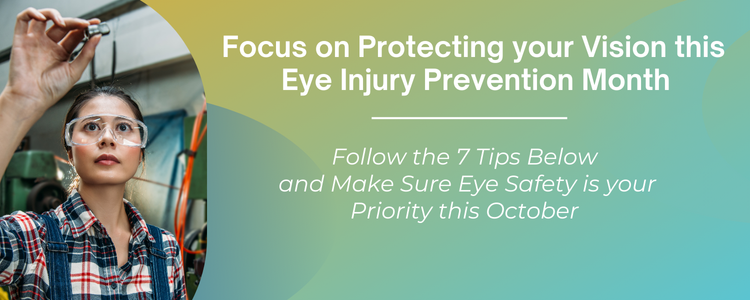Protecting Your Vision: Essential Tips for Eye Injury Prevention Month
September 30, 2024
October is Eye Injury Prevention Month, a critical time to raise awareness about the importance of protecting our eyes from injuries. While we often think of eye health in terms of vision care, preventing eye injuries is just as important for maintaining good eyesight throughout our lives. Every year, thousands of people experience eye injuries that could have been prevented with simple precautions. Whether at work, at home, or during recreational activities, taking steps to safeguard your eyes can significantly reduce the risk of serious injury.
In this article, we will explore the most common causes of eye injuries, practical prevention tips, and the steps you can take to protect your eyes and the eyes of those around you. By making eye safety a priority this October, we can all contribute to reducing the incidence of preventable eye injuries.
1. Understanding the Importance of Eye Injury Prevention
Eye injuries can range from minor irritations to severe trauma that results in permanent vision loss. According to the American Academy of Ophthalmology, approximately 90% of all eye injuries are preventable with the proper safety measures. Eye Injury Prevention Month serves as a reminder to take proactive steps to protect our eyes and to educate ourselves and others about eye safety.
Common causes of eye injuries include:
- Work-related accidents: Construction, manufacturing, and chemical industries have high rates of eye injuries due to flying debris, chemical splashes, and exposure to hazardous environments.
- Home-related accidents: Home improvement projects, cleaning chemicals, and cooking accidents can all lead to eye injuries if proper precautions aren’t taken.
- Sports and recreational activities: Activities like basketball, baseball, and racquet sports can result in eye injuries from balls, racquets, and other equipment.
- Automobile accidents: Airbags, shattered glass, and projectiles during car accidents can cause significant eye injuries.

2. Eye Injury Prevention at Work
Workplaces, particularly those involving manual labor or hazardous materials, are common sites for eye injuries. Eye safety should be a top priority in these environments, and both employers and employees should be aware of the risks and take steps to mitigate them.

Tips for preventing eye injuries at work:
- Wear appropriate eye protection: Depending on your work environment, this could include safety goggles, face shields, or full-face respirators. Ensure that the protective eyewear is ANSI-approved and fits properly.
- Use machine guards and safety barriers: These can help protect against flying debris, sparks, and other hazards.
- Handle chemicals with care: Always wear safety goggles when working with chemicals, and be sure to follow proper handling and storage procedures.
- Keep your workspace clean and organized: Clutter and spills can lead to accidents. Maintain a tidy workspace to reduce the risk of falls and injuries.
3. Eye Safety at Home
Home is a place where we often let our guard down, but it’s also a common location for eye injuries. From gardening and home repairs to cooking and cleaning, many household activities can pose risks to your eyes.
Tips for preventing eye injuries at home:
- Wear protective eyewear during home improvement projects: Drilling, sawing, and hammering can produce flying debris that may cause eye injuries. Always wear safety goggles when working on DIY projects.
- Use caution with chemicals: Cleaning agents, pesticides, and other household chemicals can be harmful to your eyes. Wear goggles when handling these substances and ensure proper ventilation.
- Protect your eyes while cooking: Hot oil, steam, and sharp objects like knives can all be hazardous. Be cautious when handling these items, and avoid splashing hot liquids.
- Secure loose rugs and remove tripping hazards: Falls can lead to eye injuries if you strike your face or head. Keeping your home free of tripping hazards can help prevent accidents.

4. Sports and Recreational Eye Safety
Sports and recreational activities are enjoyable but can pose significant risks to your eyes. According to Prevent Blindness America, sports-related eye injuries account for more than 40,000 cases of emergency room visits each year.

Tips for preventing sports-related eye injuries:
- Wear sport-specific protective eyewear: Use eyewear designed for your sport, such as polycarbonate goggles for basketball, racquetball, or soccer. Regular glasses and sunglasses do not provide adequate protection.
- Be aware of your surroundings: In team sports, be conscious of where other players and objects are to avoid collisions.
- Use safety equipment correctly: Helmets, face shields, and protective eyewear should be worn as intended and in good condition.
- Avoid playing with broken or damaged equipment: Damaged gear can pose additional risks. Regularly inspect and maintain your sports equipment.
5. Eye Injury Prevention for Children
Children are naturally curious and active, which can sometimes lead to accidents that result in eye injuries. Ensuring that children understand the importance of eye safety and providing them with the right protective gear is essential.
Tips for preventing eye injuries in children:
- Keep hazardous materials out of reach: Store chemicals, sharp objects, and small toys that could pose a risk to young children safely.
- Provide proper supervision: Monitor children during activities that could pose risks, such as playing with toys that have small parts, using arts and crafts supplies, or participating in sports.
- Teach eye safety: Educate children about the importance of eye safety, including not running with sharp objects and wearing protective eyewear when needed.
- Choose age-appropriate toys: Avoid toys with sharp edges, projectiles, or small parts that can break off and pose a risk.

6. First Aid for Eye Injuries
Despite our best efforts, accidents can still happen. Knowing how to respond quickly and effectively to an eye injury can prevent further damage and promote healing.

First aid tips for common eye injuries:
- For chemical splashes: Rinse the eye immediately with clean water or saline solution for at least 15 minutes. Seek medical attention right away, as chemical burns can cause serious damage.
- For foreign objects: Do not rub the eye. Try to blink to allow tears to flush out the object. If the object is still in the eye, seek medical attention instead of trying to remove it yourself.
- For blows to the eye: Apply a cold compress gently to reduce swelling. Do not apply pressure, as this can worsen the injury. If you experience persistent pain or vision changes, see a doctor immediately.
- For cuts or punctures: Do not wash the eye or remove any embedded objects. Cover the eye with a rigid shield, such as the bottom of a paper cup, and seek immediate medical help.
7. Eye Health Checkups: A Crucial Preventive Measure
Regular eye exams are a key part of injury prevention. Eye exams can help detect potential issues before they become serious problems and ensure that your vision is protected. During Eye Injury Prevention Month, consider scheduling an eye exam for yourself and your family members, especially if you’ve experienced any eye discomfort or vision changes.
What to expect during an eye exam:
- Visual acuity test: This checks how well you see at various distances.
- Eye pressure test: This measures the pressure inside your eyes and can help detect conditions like glaucoma.
- Comprehensive eye exam: Your doctor will examine the internal and external structures of your eyes and may perform additional tests based on your health history.

Conclusion
Eye Injury Prevention Month in October is a timely reminder of the importance of safeguarding our vision. Eye injuries can happen anywhere—at work, at home, or during sports activities—but with the right precautions, most of them are preventable. By wearing appropriate protective eyewear, practicing good safety habits, and educating those around us, we can significantly reduce the risk of eye injuries.
This October, take a moment to assess your daily routines and make the necessary adjustments to protect your eyes. Whether it’s wearing safety goggles during home repairs or teaching your children about eye safety, every small step counts. Remember, your vision is precious—take care of it today to ensure a lifetime of healthy sight.





